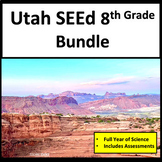Renewable and Nonrenewable Resources and Distribution of Natural Resources Unit
- PDF
What educators are saying
Also included in
- This bundle is for Indiana Science Standards 7th Grade. It covers all the standards for 7th-grade science in Indiana. This is a full-year bundle for the Indiana Science Standards for 7th grade. This bundle covers all the 7th-grade standards and gives your science activities for the year! Aligns withPrice $133.60Original Price $167.20Save $33.60
- This NGSS Middle School Science Bundle is my biggest bundle! It includes all my middle school science units, Bell Ringers, Jeopardy-style games, Assessments, and Informational Text Science Units for Middle School. It addresses all the NGSS standards for 6th, 7th, and 8th Grade NGSS science. Save whePrice $489.55Original Price $699.35Save $209.80
- This bundle is for the Earth and Human Activity Strand for Middle School Science. Students should understand the impacts of humans on natural resources, the impacts of natural hazards on humans, and the impacts of human activity on Earth processes. ✅ Save 20% by purchasing as a bundle! This bundlePrice $34.44Original Price $43.05Save $8.61
- This Bundle for Utah SEEd 8th grade includes science resources for each strand and standard. Each unit included addresses specific Utah SEEd standards for 8th grade science. Students will love these engaging activities for Utah SEEd 8th Grade. You will love saving time by having someone create resouPrice $122.04Original Price $152.55Save $30.51
- Do you want to save time in planning for middle school science? This Middle School Science Curriculum Bundle addresses all the DCIs for Middle School NGSS. Complete units with phenomena-based 5E Science Lessons for 6th, 7th, and 8th Grade.Save more than 30% by purchasing this bundle! ❤️ Get back toPrice $304.32Original Price $434.75Save $130.43
- This is a bundle for 7th Grade: NGSS Integrated Model. This bundle covers the PEs and standards for NGSS for 7th grade in the California Preferred Integrated Model. Purchase of this bundle will save you 20% on these science resources. If you teach 7th grade in California, you need this bundle.This IPrice $111.80Original Price $143.00Save $31.20
- This is a full-year earth and space science curriculum bundle. If you teach middle school earth science, you need this bundle! It is perfect for schools where 6th-grade science addresses all the Earth and Space Science standards. This bundle will save you 20% and cover all the Earth Science StandardPrice $132.04Original Price $165.05Save $33.01
- Do you teach 7th-grade science in South Carolina? This bundle is a year-long set for 7th-grade South Carolina based on the South Carolina College and Career Readiness standards. My resources include phenomena, Science and Engineering Practices, and Crosscutting Concepts. Students will love the variePrice $108.40Original Price $135.50Save $27.10
- Do you teach 8th-grade science in Kentucky? You need this science bundle! This Kentucky 8th-grade bundle covers all the standards for Kentucky eighth-grade science. It is a full-year bundle, and you save 20% on these resources by purchasing in the bundle! Over 800 pages and slides!Benefits of thisPrice $97.00Original Price $121.90Save $24.90
Description
Do you need to teach about Distribution of Resources on Earth? Students will learn that the uneven distributions of Earth's mineral, energy, and groundwater resources result from past and current geoscience processes. Students will learn that some natural resources are renewable and some natural resources are nonrenewable. ♻️♻♺
This resource on Natural Resources includes:
- a suggested schedule
- three pages of informational text
- three maps and a chart
- response pages
- interactive notebook folds
- a quiz
- answer keys for everything
Teachers Love This Resource!
Sandy ⭐️ ⭐️ ⭐️ ⭐️ ⭐️ Extremely Satisfied
A wonderful resource for teaching about the distribution of natural resources. I think it is well-aligned to the standard for middle school science and the information is presented in a way that the students understand.
Krista ⭐️ ⭐️ ⭐️ ⭐️ ⭐️ Extremely Satisfied
This is a wonderful resource. It really helped my students understand the concepts and was aligned well with the standards. Great resource!
Students will learn that geoscience is the reason for the uneven distribution of mineral resources. Students will learn that some resources are renewable and other resources are nonrenewable.
This resource is aligned with:
✅ NGSS MS-ESS3-1.
Construct a scientific explanation based on evidence for how the uneven distributions of Earth's mineral, energy, and groundwater resources are the result of past and current geoscience processes. [Clarification Statement: Emphasis is on how these resources are limited and typically non-renewable, and how their distributions are significantly changing as a result of removal by humans. Examples of uneven distributions of resources as a result of past processes include but are not limited to petroleum (locations of the burial of organic marine sediments and subsequent geologic traps), metal ores (locations of past volcanic and hydrothermal activity associated with subduction zones), and soil (locations of active weathering and/or deposition of rock).]
✅ Utah SEEd Standard 8.4.1
Construct a scientific explanation based on evidence that shows that the uneven distribution of Earth's mineral, energy, and groundwater resources is caused by geological processes. Examples of uneven distribution of resources could include Utah's unique geologic history that led to the formation and irregular distribution of natural resources like copper, gold, natural gas, oil shale, silver, and uranium. (ESS3.A)
Save 20% by purchasing as part of this bundle Earth and Human Activity for Middle School
These resources are created by Lynda R. Williams at Teaching Science
Follow me and get news of my new resources. Each new resource is discounted by 50% for the first 24 hours!
You will love my other resources for middle school science!
Exothermic and Endothermic Reactions
Thermal Energy and Particle Motion
Waves: Transmission, Absorption, and Reflection
Analog and Digital Signals
Related Products
• Earth and Human Activity Bundle
• Human Impact on the Environment & Protecting Earth's Resources
• Human Impact on the Environment MS ESS3-3
• Human Population and Resource Consumption
• Geoscience Processes & Changing Landforms MS-ESS2-2
Save 20% by purchasing as part of this bundle Earth and Human Activity for Middle School
These resources are created by Lynda R. Williams at Teaching Science
- Follow me and get news of my new resources.
- Each new resource is discounted by 50% for the first 24 hours!
You will love my other resources for middle school science!
Exothermic and Endothermic Reactions
Thermal Energy and Particle Motion
Waves: Transmission, Absorption, and Reflection
* My resources are secure and not editable for copyright reasons.














